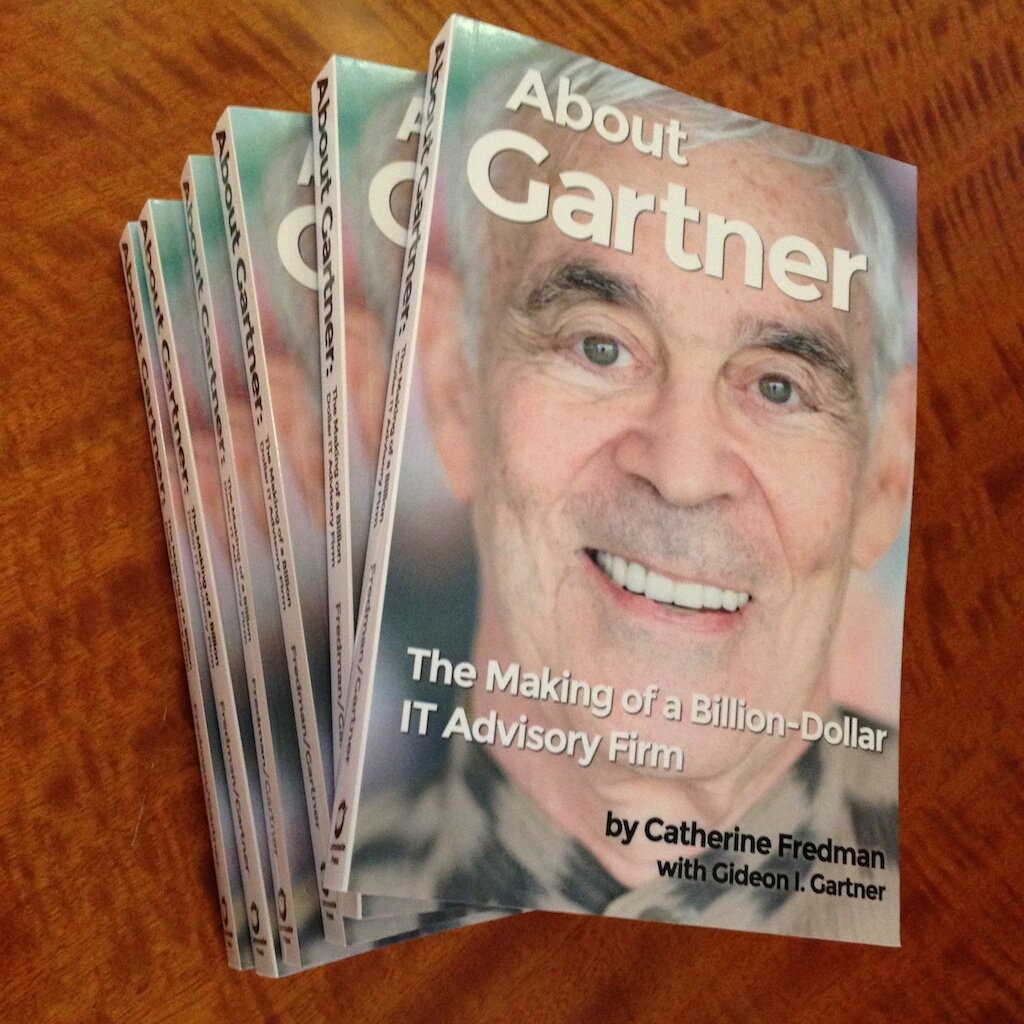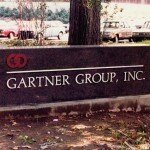Part 1: AFTER HUTTON & OPPENHEIMER, VCs INTERVENE

Neill Brownstein asked “Gideon, why do all this on behalf of Oppenheimer when you could be doing it for yourself?”
In early 1970 E.F. Hutton hired me as a technology analyst, despite my having little financial background. One of my early successes was a detailed and timely report on Xerox Corp., then a ‘nifty fifty’ firm with steady growth and broad popularity among institutional investors. The report raised concerns that Xerox’s growth might be slowed, and it soon seemed as though every money manager in the country was asking that I visit and elaborate. This early experience put me on the map, as by necessity I had shifted from the Street’s traditional emphasis on finance, to the nitty gritty of product and service functionality. One day in late 1971, Peter Mandrakos who was both an excellent and friendly client, surprised me by saying “you should speak to my uncle Leo Mandrakos who’s head of research at Oppenheimer; he’d like to call you… and by the way, you really shouldn’t be at Hutton”.
I knew that Oppenheimer & Co. (Opco) was one of the top investment research firms on the street, and after Mr. Mandrakos called me directly, we met for an interview lunch at the Opco partner’s dining room. I assumed that he was leaning towards possibly recruiting me , but felt that I owed Hutton loyalty for having hired a relative novice (me), into my new and challenging career. But Leo Mandrakos persisted; we met twice more before Hutton’s internal politics became so stressful that one day I instinctively picked up the phone, called Leo, walked the few blocks to his office, and signed up with my second Wall Street firm in two years.
I did well at Opco; soon after I joined in July ’72, Forbes wrote me up, and by the time October arrived I was ranked #2 in technology by the journal ‘Institutional Investor’ (which had been founded five years earlier by Gil Kaplan who designed and integrated Wall Street’s most extensive analyst evaluation system, into the magazine). The following year I made the #1 position, but dropped back to #2 every year thereafter through 1977, during which time both G.S. Grumman and G.A.Saxton formed 6-9 person teams of technology analysts, and alternated between the #1 and #3 places each year! (This might be judged a non-orthodox but brilliant stroke by Gil Kaplan, in somehow balancing the contrasting effectiveness of an individual vs. a team!)
So much for background.
In ’78 at the opening cocktail party of the American Electronics Association’s annual conference in Monterey CA, I bumped into Neill Brownstein, a partner at Bessemer Venture Partners who I had met before. Neill and other VCs were there to track small public companies, learn more about the latest technologies, and to network! After the opening party several of the larger banking firms would host dinners for their best institutional clients, to dine with CEOs of companies in which they had invested; and since neither Neill nor I qualified, we decided to head for one of the fish joints on the Monterey wharf.
At dinner, Brownstein remarked on my reputation as Oppenheimer’s’ IBM watcher’ and I replied that this image suggested a narrow focus, and that I had in fact diversified my interests and knowledge regarding many other IT industry players, not just IBM! Brownstein asked question after question, and insisted in learning more about my background: that after attending MIT‘s Sloan School, I spent two years with IBM in Paris and Tel-Aviv, followed by six more in its U.S. ‘Commercial Analysis Department’ where IBM microscopically analyzed its competition…. and that after being promoted and sent to IBM management school, my department was responsible for IBM’s COMpetitive STATistics (COMSTAT) which tracked competition in great detail…. which led to my first innovations, involving both graphic reporting and ‘war rooms’… finally leaving IBM to start my first business… under-funded and not surviving the recession of ’69, when out of the blue, Wall Street’s E.F. Hutton called, and I listened….and was hired and 1.5 years later recruited to Oppenheimer (Opco.)!
Brownstein perked up when after asking me about my Opco. activities, he heard what sounded like a complaint, that as a stand-alone IT industry analyst at this research powerhouse, I could not cover the vast IT industry due to insufficient staff support (Opco’s strict policy of ‘one senior analyst per industry’ diluted my opportunity to compete with Grumman and Saxton, each of which had recruited six or seven analysts). I continued describing how I finessed the situation via differentiation: I’d deliver ‘Gideon Says’ messages to our salespeople almost daily, allowing them to promote my ‘continuous’ research to our best clients at least, and that I had begun collecting business cards at conferences such as the one we were attending, in order to create a mailing list of IT executives!
Brownstein chimed in: “I get your stuff too”, and this statement somehow led to my divulging that Opco finally allowed me to create a priced service for non-financial IT executives, based upon my continuous flow of written commentary plus quarterly meetings at our fancy offices. Why had Opco agreed to that? Because I had argued that our subscriber ‘hard-dollar’ revenues would surely fund several new hires, allowing us to better compete against my nemesis firms: Grumman and Saxton!
My first hire was an ex-client of mine working in Paris for SoGen Swiss who I’ll call O.A., who contributed an edgy and unique source of IT insights from Europe. And with O.A.’s help soon after, we hired Bill McAffery to drive our sales effort (McAffery was one of the founders of McAffery/Seligman/VonSimson, later called ‘The Research Board’ which much later was acquired by Gartner!). Yes, Brownstein seemed to agree that we were succeeding in building a small but neat little business.
As dessert was served, Brownstein looked straight into my eyes and asked, “Gideon, why do all this on behalf of Oppenheimer when you could be doing it for yourself?”
Did I hear this VC imply that he had a new start-up in mind, with my involvement? Quit Opco?? My mind raced as Neill reinforced his interest, he was now doing most of the talking, and at one point I actually disclosed that since my first business failure in 1969 (for which I could offer legitimate reasons), I harbored an ambition for another try. I had been a client of IT market research companies such as IDC and was quite unimpressed, which led me to feel convinced that there was opportunity.
We both now seemed to be on the same page; I had thought entrepreneurs pitched their investors, not visa versa, and the irony of what seemed to be transpiring was shocking!
Part 2: WEIRD VC NEGOTIATIONS

Brownstein was an innovator himself, and he somehow had seen an opportunity where most others would not have! I recall sensing that I might be able to strike a deal with less effort and more speed than the normal VC/entrepreneur negotiations.
When I asked “What would a deal look like?”, Neill pulled out the proverbial envelope from his jacket pocket and scratched out some numbers which the reader knows eventually led to Gartner Group (now Gartner Inc.). Of course the deal details evolved, and Neill (plus other investors) would be in the driver’s seat, but as long as I’d be working with ‘other peoples money’ (OPM) rather than my own, that seemed OK at the moment.
At the company ’4-Phase Systems’, Neill was a fellow board member with Christopher Brody, a general partner at E.M. Warburg Pincus. Neill asked that I meet with him so that we’d soon be in a position to discuss a deal. I had nothing to lose, so Chris and I met and we had a 100% meeting of the minds. Within another two weeks, the VCs delivered an outline of a proposed structure, as follows: the company would be capitalized with 6,250 shares of preferred stock at $100 per share, which the VCs would purchase ($625,000). Simultaneously, 100,000 shares of common stock would be issued at fifty cents a share ($50,000 total equity investment), divided one-third to me as founder, one-third to other management and key personnel, and one-third to the two VCs. My own investment for 1/3 of the $50,000 equity, would be a very affordable $17,000!
But I had not studied the proposal carefully enough: in small print which I glossed over, the 6,250 shares of preferred stock was named a ‘two-times (2X) preferred’ issue. Of course I’d heard of preferred, but I was ignorant of what 2X preferred was! It meant that in addition to its 8% interest rate, the preferred would carry an additional coupon, whereby the preferred’s face value would increase at the rate of 15% a year, quite apart from the 8% annual interest. In other words, in five years the face value of the preferred , would grow to $1,250,000 instead of $625,000 (ex the 8% interest on the $625K)! This meant that were we to not pay down the total face value of the preferred within five years, the outstanding preferred would convert to common, and voting rights would shift in favor of the VCs who would then have a clear cut controlling interest, and would be able to force management changes and/or recapitalization in their favor! All this for their relatively small investment.
Luckily at the time, and because I didn’t quite know what I did not know about start-ups and venture deals, I had enough confidence to continue our discussions. In retrospect, I was lucky that I accepted the deal, in a situation where prudent analysis might have convinced me to walk! I don’t recall my exact thinking, but must have rationalized whatever downside existed on the assumption that dilution must be lived with, that we’d likely survive as a business, and that I could always get a great job on Wall Street again. After all, the VCs were also accepting risk (I assumed that they could not have sensed a sure thing, since every start-up entails risk).
I had studied the major players and I was now creating a brand new concept in technology advice and market research. I rushed to complete all elements of a plan which included deliverables, sales approach, and even company culture, all designed to be different and hopefully of greater value than what I had learned about the competition. At home, I finished documenting the detail elements of the plan; most controversial were the synergies which I hoped would develop if we attacked three client categories simultaneously: IT vendors, and users, and investors! this turned out to be a bone of contention with the VCs who said, “Gideon, you cannot start three companies at the same time”, but I won that argument. I certainly could not have imagined that we would end up establishing a dominant position in our niche, and with competition never catching up! But my projections turned out to be remarkably accurate for our first five years, slightly low on revenues and slightly high on profits.
While negotiations with the VCs were proceeding slowly in the background, I naturally continued producing for Oppenheimer in the foreground. Steve Robert was now Opco’s President, and had been pushing me for several months to sign a non-compete agreement with regard to the new industry-oriented business which I had initiated and was now building for Opco with the help of O.A. and Bill McAffery. Obtaining a non-compete from me was likely sound management from Opco’s point of view, but that would have ended my VC negotiations, and so I stalled! I rationalized this for good reason: Steve had never offered anything in return for my signing, no quid pro quo which I believed was called for. I did hear rumors that I was being considered for a full Opco partnership, but I did not ask Steve for clarification, nor did he address the issue, so I did not take the rumor seriously.
And the VCs kept reminded me that I must first find at least one strong partner with an appropriate skill set; they could certainly not fund a business with a staff of one! We were all starting from scratch and I was then just a one-man-show. It was clear that I’d have to recruit at least one other super-talented professional before they would actually fund the new business. Neill had already raised the issue and I had immediately called a professional acquaintance, David Stein, with the idea that he join me as co-founder; Luckily, my discussions with Dave Stein were progressing; he had been recommended to me a year earlier when I needed a tech guru to help on a project which had somehow fallen into my lap; with Opco’s consent and while I continued my analyst responsibilities there, the part-time work we completed for the French company Thompson CSF (which wished to acquire Calcomp) turned out extremely well received. And soon after, we teamed up again on behalf of Storage Technology; what a team we seemed to be, in both cases Dave was the tech genius while I was the inferential analyst, and we bonded. David would later turn out to be a ‘critical success factor’ for the business during our first five years of operations.
Before the VCs were ready to complete funding, and in parallel with our deal discussions, I approached and discussed my new business idea with two very major VCs who I knew reasonably well, Fred Adler (Adler&Co.) and Stuart Greenfield (Oak) to see if they liked the idea and the opportunity, and might they wish to possibly join the two “unnamed” VCs who were already working with me. They both declined, and interestingly for the same reason: they both had fundamentally negative attitudes re investing in ‘people businesses’, because such enterprises ‘have less inherent leverage than manufacturing companies’! Stuart Greenfield has remained a close friend of mine for many decades, and recalls his firm’s turning me down vividly, while blaming the decision on his partner!
By September ’78 I was finishing details of the business plan, but there was still no final deal, not even a firm term sheet from the VCs, and I was still negotiating with Dave Stein to join me while the VCs reminded me that I must find at least one strong partner with an appropriate skill set; they could certainly not fund a business with a staff of one! David had been my first and only call in finding a partner for the pending new business with the VCs; I kept bringing him up-to-date on what was transpiring and it took several more weeks of twisting his arm before he agreed to quit Harris Corporation in Florida to join us. He would be co-founder of the firm for 10% common stock ownership, but responsibly, we all agreed that he could only join after our deal closed!
The VCs and I had discussions as to the new company name, and Neill Brownstein instantaneously piped up: “Gartner”.
Part 3. THE DRAMA

It was now my sixth year at Opco and our new side-business with senior IT executives had 15 clients. But Mr.O.A. who had been hired to be an analyst, seemed to be contributing G2 via his French connections, but produced little analysis for our financial clients (one of the reasons he had become unpopular with the Opco sales force). Meanwhile, my overall workload was extra heavy, resulting from the combination of Opco’s research & financial client support requirements; plus the new Opco IT business which I was still helping to support; plus the continuing VC negotiations (including business planning and recruiting); and plus my marital divorce proceedings to boot! But my major concern was dealing with the VCs; despite the salary they offered ($25K vs. my roughly $200K at Opco) I kept plugging, and finally completed the detailed business plan.
The day was approaching when I might cut the cord and leave Oppenheimer, and I felt guilty while preparing to leave it without disclosing to anyone. I needed to talk to at least someone about my conflict, and I chose to confide in Bruce Brandeleone, Opco’s executive manager of its ‘institutional sales’ department. We met, and when I mentioned the VC negotiations he expressed shock! He repeated his view that among our twenty-five or so senior analysts, I was one of five who ‘carried’ the department and was therefore indispensable (thanks Bruce!). But he did emphasize that he would not disclose my probable exit, while repeating yet again that his sales force would not relish losing one-fifth of its ‘heavy hitters’. Before our discussion ended he insisted on our brainstorming possible deals which would encourage me to stay.
I shared my dilemma with Neill and Chris; the VC’s negotiating style was immediately challenged and the aggressive Chris Brody seemed mad and said something like: ‘Wait one minute! you can’t expect us to go to our investment committee and get a final commitment, while you’re still negotiating with Oppenheimer, and possibly let Oppenheimer take the business away from us’! How ironic that it was already the VC’s business! I understood his point, and deep down I was sympathetic. I think I must have turned red, while Neill tried to break the developing impasse; he said: ”Look, let me suggest what you should do: why not ask Oppenheimer to join us in the deal and make them our partner?”.. he continued to explain why Opco should be asked to join Bessemer and EMW Pincus, investing in and supporting our new company in equal partnership with these two VCs…. and, Opco would not only benefit from returns on its small equity investment , but also become our Wall Street merchandising arm with much greater volume of high-quality research, benefiting Opco’s institutional clients and likely even beating Saxton and Grumman!
Brilliant! Chris and I simultaneously concurred that the deal which Brownstein described would be a no-brainer for Opco to at least consider, and likely accept. The next day I shared Neill’s vision with my friend Bruce Brandeleone who immediately acknowledged its merit, and with his help I convened a small meeting to be held with himself, research director Burt Fingerhut and of course, our president Steve Robert. I also huddled with Dave Stein and asked whether instead of doing the VC deal he’d ever be willing to join Oppenheimer with me; but he was definitively not inclined to leave Harris Corporation for ‘just another employer’, compared with being the co-founder of a new company supported by VC giants.
The very next day all of us found time to meet together in one of our small conference rooms. The evening before I had prepared flip charts, and as the meeting began I confidently stood up with them, and enthusiastically presented Neill’s concept, which I expected would be viewed as a huge opportunity for all. But this was in fact the first time Steve heard anything about my pending relationship with VCs, and he was clearly upset. I explained how these VCs approached me (true), how through my loyalty to Opco I had prevailed upon them to invite Opco to be their their partner (yes, I borrowed Neill’s idea), and that the capital to be invested in the new firm would actually strengthen Opco’s technology research position, which would offer it a significant upside. Throughout, even while watching Steve’s growing nervousness, I expected my presentation to be a no-brainer opportunity for Oppenheimer; a win-win for all.
Who knows explicitly what went on in Steve’s brain while I was describing Neill’s fairly simple but logical idea. Of course I had figured that he would need to obtain approval from the Opco’s higher-ups (its Executive Committee), but I recall that after my first or second sentence Steve was was not even paying attention! He undoubtedly had a large ego and might not be able to shake the fact that I ‘pushed’ him around for some time by my not willing to sign the Opco non-compete.
What Steve should have thought was: ‘Yes, Gideon is a pretty canny chap, avoiding my non-compete requests while figuring out and designing a way for all of us to benefit…G’s idea is a no-brainer, especially with first-class Bessemer and Warburg to boot!’
Steve should have realized that the new Opco business with O.A. and McAffery but without my research, would likely turn out to be a side-show with regard to scale, whereas the stature of the VCs and their judgment that the new firm (financed by all three companies) would be very successful and benefit Oppenheimer substantially! But despite his overall intelligence Steve really blew it! At least he should have realized that even if he didn’t love our proposal, he could have immediately offered me the full Opco partnership! (In retrospect, I think that would have cemented my loyalty to Opco!) Instead, Steve was likely turned raging mad internally, I recall that I thought he grew pale, turning to Fingerhut and asking “Bert, did you know that Gideon was working with Venture Capitalists?” Burt had not known anything of the sort, and Steve immediately rose and stalked out of the room.
Word spread quickly, and for two weeks the Oppenheimer salesforce was vocally upset, but even as a group it obviously had no clout. Several senior Opco partners called me to their office and tried to convince me that leaving would be a huge mistake; Bruce Brandeleone told me that he tried to explain to Steve the new opportunity, but made no headway while possibly compromising his own career in taking an overt stance on such an emotional issue.
Objectively, I assumed that Steve never studied the pros and cons which should have led to a different outcome. I met with Jack Nash, who with Leon Levy were the firm’s famous founders! Jack was known as a very tough guy: of course he listened to my story, but quietly responded that this was Steve’s baby, and that he would not meddle (I suspect that he had been briefed by Steve, and perhaps had actually put hi two cents in, because the next day day or two, Steve visited me in my office and actually offered an alternative solution:
He proposed that my small staff of O.A. and McAffery would be funded as a separate entity within Opco, I’d obtain a 25% equity interest in the new business and become a full Oppenheimer partner (finally!). In other words, Steve was asking me to drop the VCs, for a very tempting offer. But it was too late, the environment had been poisoned and I did not wish to upset Brownstein and Brody who had backed me through all this tumult. Almost daily I had been notifying the VCs of the drama’s status, and I finally gave them an OK that I was with them! By now they had completed all the new firm’s documentation requirements, and Dave Stein could finally quit Harris. Within two days ‘Gartner Group’ was official, a reality!
O.A. and McAffery asked to visit with Dave and me, and we met; they actually felt wounded by our not trying to bring them into the VC picture! Dave’s and my interpretation was that they worried whether Opco might not have further use for them! We ourselves had concerns about these two who after I had Opco hire them, tried to monopolize the user business! But we thought through the variables again and quickly agreed that we would not even consider this new option, even though had we agreed, Oppenheimer would have been forced to transfer the 17 clients to our new firm, which would likely have given us a quick start at Gartner Inc. We both understood that we were losing a significant revenue opportunity, but stuck to our guns with regard to the types we wished to hire, and also hoped that we might be able to convince the clients that with my leaving they could legally break their Opco contracts.
It was now April 1, 1979, and during the ensuing month David and I called or visited most of the seventeen ‘hard dollar’ clients, which in fact were legally tied to Oppenheimer via their annual contracts; the clients included Xerox, Pepsico, Proctor&Gamble and 14 others, and I recall only three who were open to the idea of cancelling their written contracts based upon staff changes and the loss of my research. But Opco and O.A./McAffery were now claiming that they would be hiring my replacement, so the clients would receive similar research reports to mine (thanks, the market had thought that mine were superior), in addition to the O.A. ‘intelligence’ inputs based upon their French connections re what IBM at least considered ‘inside information’. All but three honored their Opco contractual commitments, and after their one-year contract would re-assess the situation; we accepted the assumption that some but not all were quite pleased with what O.A. and McAffery were delivering.
—————————————————
The inexplicable then occurred! Just three weeks later O.A. and McAffery quit Oppenheimer to join Dean Witter & Co.!! The two chaps were obviously aware of their unpopularity with the Opco salespeople , and must have questioned Opco’s attitude towards them, and also likely assumed that Dean Witter & Co. would inherit most of the Oppenheimer contracts. But O.A. and McAffery did not count on what immediately transpired !!
Within hours of their quitting, Opco’s research manager Bert Fingerhut phoned me at home, asking that I travel downtown to his office ASAP. Not knowing why but curious, I rushed to the Opco offices, where Bert disclosed that O.A. and McAffery had just quit and expected to inherit the contracts! We immediately negotiated a bit, and swiftly signed a straightforward deal whereby Opco would sign over all of its contracts to our new company Gartner, in exchange for a 15% royalty to Opco which would decline to zero over a two year period. Gartner would thus be off and running immediately, together with our IT ‘user’ business which had always been planned to complement the IT vendor and IT investor markets, and which ironically would now give us a head start.
I hired Tom Crotty from my old firm E.F. Hutton to manage our nascent Wall Street investor group (which I was quite focused upon), and soon added other analysts with technology backgrounds. Our Warburg Pincus VC Chris Brody was friendly with Wall Street’s Dillon Read Corp., and within three months convinced it to become the content distribution agent for our Wall Street practice which we were calling ‘Gartner Securities’. Of course, we had an edge compared with other Wall Street analysts in the tech space, because a significant percentage of the research ‘Gartner’ would be producing for our vendors and users could be re-focused towards the interests of Wall Street. This was consistent with our original rationale for creating a firm which would immediately market to the three constituencies (vendor, user, investor), each of which would benefit from our understanding of the other two, where we would understand all three and where we would also benefit from considerable content overlap. Dillon Read began to pay us $500K/year and our relationship lasted for five full years at which time it was paying us $2.5M annually (an increase of $500K each year), after which we built our own trading desk and sales force for institutional investors, and called the business Soundview Financial.
In 1985, as Gartner planned to go public, our board was nervous because the Wall Street business model and financial reporting was so different than our other two major businesses, that our new shareholders might become confused. The investor business was therefore spun out as a separate company, while I remained its largest shareholder and chairman, at least for a while. The full story is at least as dramatic as the one above, and has been published as two posts, part 1 and part 2 of ‘Gartner’s Soundview: Its Rollercoaster Story’, also on the blog gideongartner.com.







8 Comments